We may receive a commission on purchases made from links.
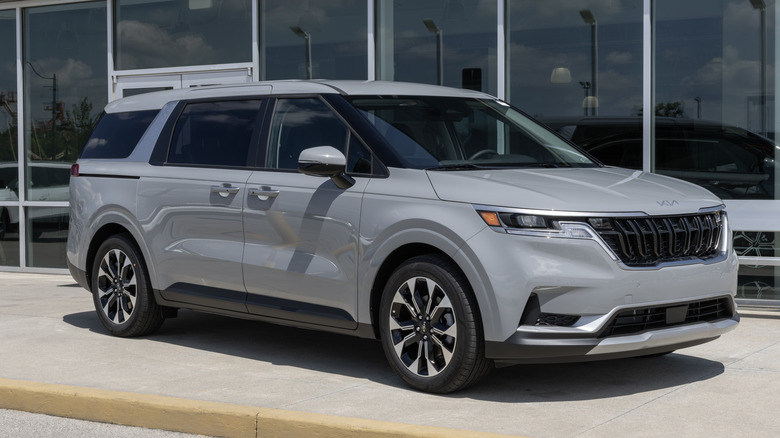
Jetcityimage/Getty Images
It’s almost hard to believe that 25 years ago, anything made by the Hyundai Motor Group was pointed at and laughed at. The interior quality wasn’t the best, the styling was drab, and overall, driving one of these vehicles was just not a good experience.
Advertisement
Fast forward to today, and things couldn’t be more different. The Hyundai Motor Group has truly risen, the story of which is documented in the Richard M. Steers book «Made in Korea.» HMG now excels at just about every aspect of building cars, including powertrains. One of the more commonly used powertrains made by the group, especially for larger automobiles, is the Lambda V6 engine.
This engine first appeared in 2006, and we’ve seen plenty of versions of it. Various capacities, induction systems, multipoint and direct injection, and even versions that run on the Eastern European favorite, LPG aka autogas or propane autogas. There aren’t many HMG vehicles left today that use the surprisingly sturdy and powerful Lambda V6, but there are still a few that you can buy, as well as a handful of pretty recent ones on the used market.
Advertisement
Kia Telluride
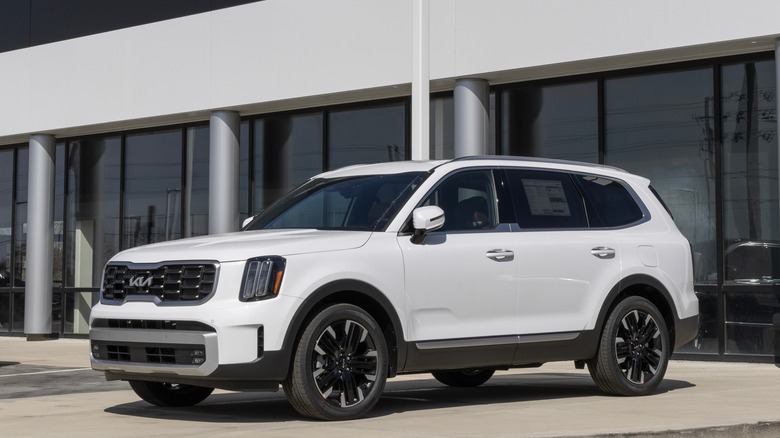
Jonathan Weiss/Shutterstock
At the start of the 2020s, Kia revealed its largest SUV for the North American market that would provide transportation for larger families at an affordable price. One step above the Sorento, the Telluride can be seen as a spiritual successor to the Borrego. While the Borrego was a total flop, however, the Telluride has proven much more successful, and with good reason.
Advertisement
While the rest of Kia’s lineup embraces electrification to various extents, Telluride takes the much more old-school approach. Under the hood is the 3.8-liter version of the Lambda V6. No turbocharging and certainly no hybrid component, which sadly does cost the Telluride quite a few MPG.
In the Telluride, the Lambda makes 291 horsepower and 262 lb-ft of torque, which are pretty healthy figures. When equipped correctly, the Telluride can tow up to 5,000 pounds, which is pretty good for the class. It’s admirable that Kia has persisted with naturally aspirated V6 power, but it’s safe to assume that the Telluride in this form is not too long for this world.
Hyundai Palisade
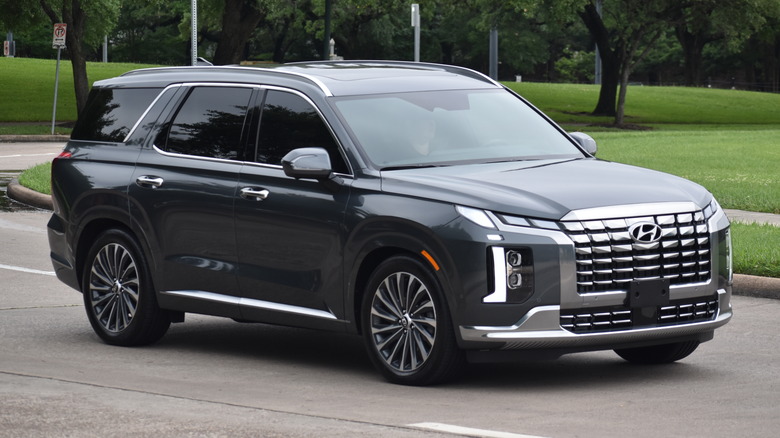
Artistic Operations/Getty Images
Let’s say the Kia Telluride’s styling is a little bit too adventurous and boxy, and you want something that’s more flowing and modern, with an air of luxury about it. That’s when the Hyundai Palisade comes in. The two share the same platform and powertrain, but the Palisade takes a very different approach to the styling. In a lot of ways, the Palisade is a strong performer.
Advertisement
Even though the Santa Fe is now almost the same size, the Palisade is still at the very top of Hyundai’s SUV lineup in North America. Under the hood of the Palisade is the exact same 3.8-liter Lambda V6 as the Telluride, putting out 291 horsepower and 262 lb-ft of torque, with the same eight-speed automatic transmission and the same ability to tow 5,000 pounds.
This means no electrification, and it also means not the absolute best gas mileage. In the end, it all comes down to preference and taste. The Palisade’s trim levels focus more on old-school luxury, while the Telluride is more for the adventurous explorer type of buyer. However, the Lambda V6 does a great job here.
Kia Carnival
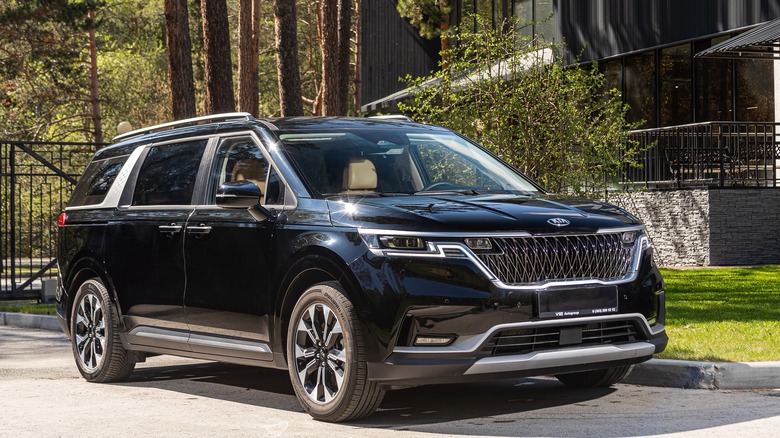
Everyonephoto Studio/Shutterstock
Despite the market and consumer tastes shifting towards the SUV, North America is not ready to give up on the minivan. The Kia Carnival arrived in 2022, ending the Sedona nameplate’s run in North America. Even though it does have typical minivan styling traits, there is a whiff of SUV in the styling department, because it’s an unwritten rule that basically every new car needs to have at least one SUV-like styling trait.
Advertisement
Joking aside, the Carnival is one of the last HMG vehicles in North America to still offer the Lambda V6 engine. In the Carnival, it displaces 3.5 liters instead of the 3.8 in the Palisade and Telluride, and that means a couple of less horsepower. 287 horsepower, to be exact. The Carnival is a great minivan and a great choice for minivan buyers who want something a little bolder in the styling department.
One notable aspect is that the Carnival is also available with a hybrid powertrain in North America alongside the V6, for those who want to be a little more frugal. The V6 also has a pretty decent 260 lb-ft of torque, which will come in handy if you plan to transport eight people. Disappointingly, however, the Carnival is not available with AWD no matter which trim level you opt for.
Advertisement
Genesis G70
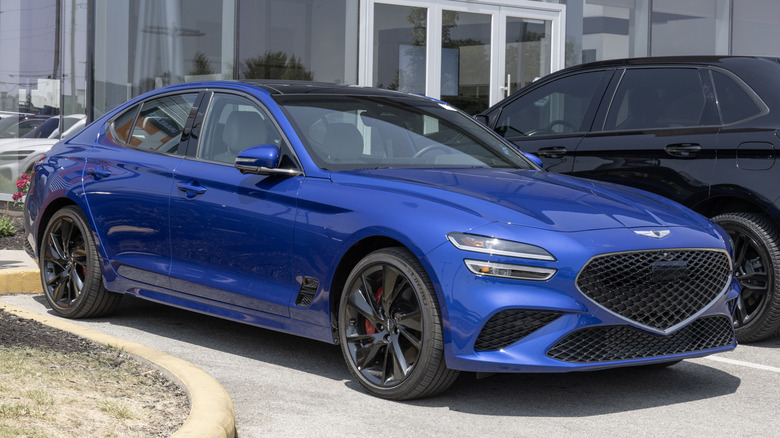
Jetcityimage/Getty Images
Genesis is the Hyundai Motor Group’s luxury brand, which was spun off from the Hyundai Genesis back in 2015. Currently, the G70 is the oldest model in the brand’s lineup from a platform and powertrain perspective. This does have its merits: the G70 is the only new car that has a lot in common with the gone-too-soon Kia Stinger.
Advertisement
That includes the same platform, but the G70 also uses the same powertrain as the Stinger. Specifically, it’s the T-GDI version of the Lambda, a 3.3-liter turbocharged V6 putting out 365 horsepower. This makes the G70 the only current Genesis model to use the Lambda, as all of the other internal combustion models in the automaker’s lineup have
In addition to this excellent engine, the G70 has another ace-up sleeve. While BMW won’t let you have an M340i without xDrive, you can pair the 3.3-liter V6 on the Genesis G70 with RWD, which is quite a good bonus point for car enthusiasts. The G70 probably won’t stick around for much longer, and one thing is for sure: it deserves more love while it’s still around.
Advertisement
Kia Stinger
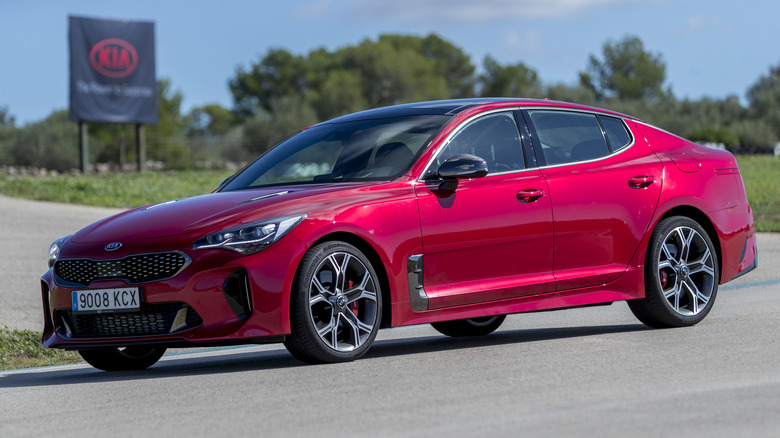
Andres Iglesias/Getty Images
The Genesis G70 is pretty expensive, and despite its chops as a sports sedan, it’s more focused on the luxury side of things. That’s where its cousin, the Kia Stinger, comes in. The Kia Stinger is undoubtedly Kia’s «let them cook» moment, as people couldn’t believe that Kia had made an M340i rival when the Stinger first appeared in 2017.
Advertisement
While it stuck pretty close to Kia’s design language of the time, the Stinger carved its own path with the swoopy fastback styling and the accentuated sportiness of the exterior, which definitely showed that the car meant business. The top-of-the-line Stinger GT used the 3.3-liter turbocharged Lambda V6 making 365 or 368 horsepower, with the option of either RWD or AWD.
The most impressive thing about the Stinger was the way it handled, which was way better than anything with a Kia badge had any right to be. It’s really a shame that the lights went out on the Kia Stinger, but good as it was, there simply wasn’t all that much interest in it.
Hyundai Equus
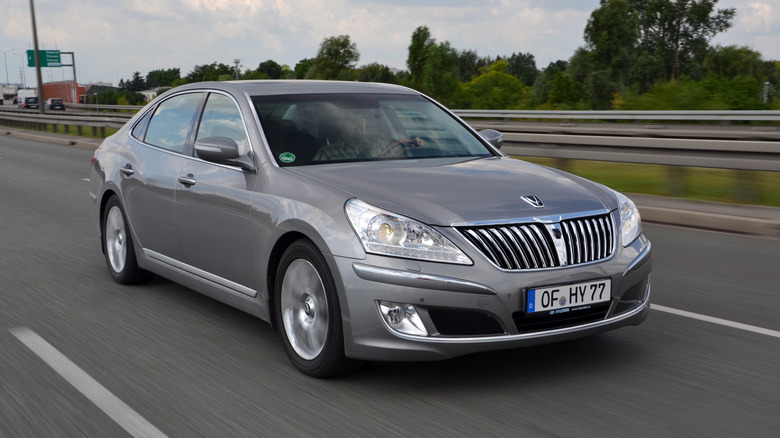
Tramino/Getty Images
Now we’re getting to the super interesting stuff. The Hyundai Equus first started out in the late 90s as a collaboration with Mitsubishi, and it was Hyundai’s flagship model in Korea. For the second generation of the Equus, Hyundai took a brave pill and decided to offer it in North America as well.
Advertisement
Along with the elusive 4.6-liter and 5.0-liter Tau V8 options, you could also have the Equus with the 3.8-liter version of the Lambda V6. Sadly, the V6 was not offered in North America, only in foreign markets. The Lambda in the Equus was of the direct injection variety, and it made 334 horsepower and 291 lb-ft of torque.
Despite the Equus being a pretty solid luxury sedan and way cheaper than its competitors, there was simply too much going against it. For one, a luxury sedan with a Hyundai badge just didn’t sit right with people. There was also the fact that the Equus clashed pretty hard with the Genesis, as both vehicles were on offer in North America. They both offered the same engine, and they were very similar in size. They even looked pretty similar. On the other hand, the Equus walked so the Genesis G90 could run.
Advertisement
Hyundai Azera
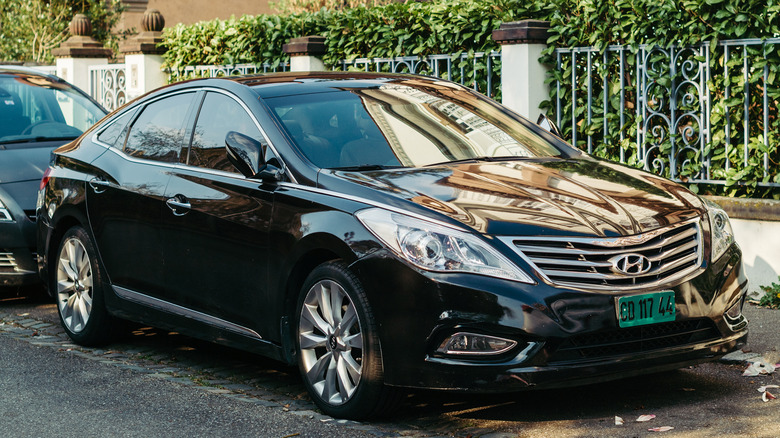
Hadrian/Shutterstock
In the early 2010s, Hyundai in North America was pretty serious about the executive car business. As well as the Genesis and the Equus, it also offered a mid-size premium sedan to the U.S. and Canada in the form of the Azera, also known as the Grandeur in Korea. The Azera was one step above the Sonata, and it came along when Hyundai was getting serious about design.
Advertisement
As was the norm with Hyundai vehicles of the time, the Azera’s USP was how much it offered for relatively little money. V6 power, tons of technology and equipment, and overall a pretty solid package for the money. The 3.3-liter Lambda V6, without a turbocharger in this instance, was the only powertrain offered on the Azera from 2012 all the way to 2017. It made a decent 293 horsepower, propelling the Azera to 60 mph in less than seven seconds. Sadly, AWD was never an option.
Hyundai’s struggles with brand image during this decade, combined with the confusing Hyundai sedan lineup of the time, meant that the Azera bit the dust in 2017, marking the last time that the U.S. and Canada would see the Azera nameplate. If Hyundai were to start selling the latest Azera/Grandeur, things might seem a little different.
Advertisement
Kia Cadenza
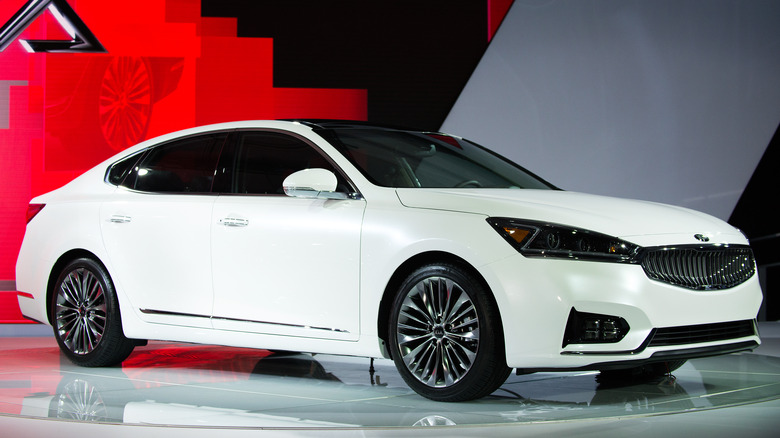
Bryan Thomas/Getty Images
It wasn’t just Hyundai that was serious about the premium sedan segment. Kia joined in on the action in the early 2010s with the Azera’s cousin, the Cadenza. The Cadenza made the long journey from Korea to North America for model year 2014, as a slightly different, ever so slightly braver alternative to the very similar Azera, and also a brave alternative to other mid-size premium sedans.
Advertisement
Under the hood, the Cadenza boasted the same 3.3-liter Lambda V6 as the Azera, delivering 293 horsepower and a 0-60 time of less than seven seconds. However, what set the Cadenza apart was its unique selling point-a single, fully-loaded trim level. This meant that the Cadenza was packed with features that no other sedan in its class could match for the same price, making it a compelling choice for discerning buyers.
The Cadenza’s fate was about the same as the Azera, though the Cadenza continued fighting a whole five model years more than the Azera, finally bowing out in 2021 alongside the larger K900. With that, the era of luxury sedans with Kia badges unfortunately wrapped up.
Hyundai Genesis Coupe
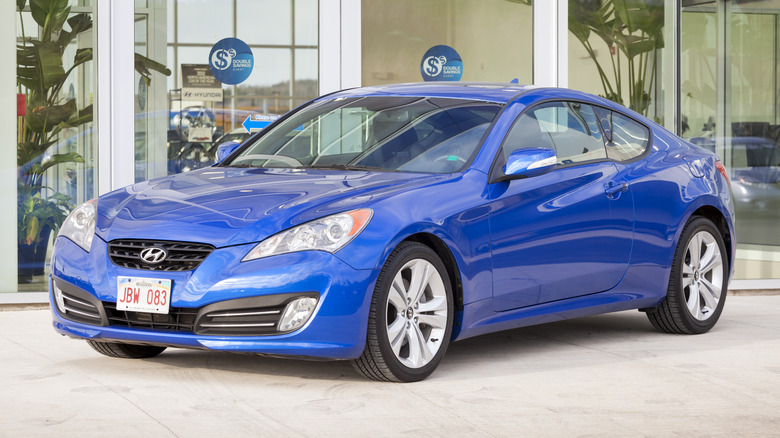
Tomeng/Getty Images
Does anyone remember this one? As part of launching the Genesis model in North America, Hyundai also brought over an actual RWD sports car to compete with the Nissan 370Z and the Ford Mustang, but at a much more reasonable price. The Genesis Coupe arrived for model year 2010 with either turbo four-cylinder power or a 3.8-liter version of the Lambda V6, putting out 348 horsepower and 295 lb-ft of torque.
Advertisement
Power went to the wheels through either a six-speed manual transmission or a six-speed automatic, and the Genesis Coupe also had a pretty good amount of style to brag about. It was more of a classic coupe shape, and Hyundai’s design language of the time actually worked very well here.
Despite the solid handling and, frankly, bargain price tag all things considered, the Genesis Coupe is still one of the most underrated RWD sports cars on the market today. As a result, used values have plummeted, and it’s definitely something you should consider if you want something that drives the rear wheels and is a lot of fun but also a little left-field.